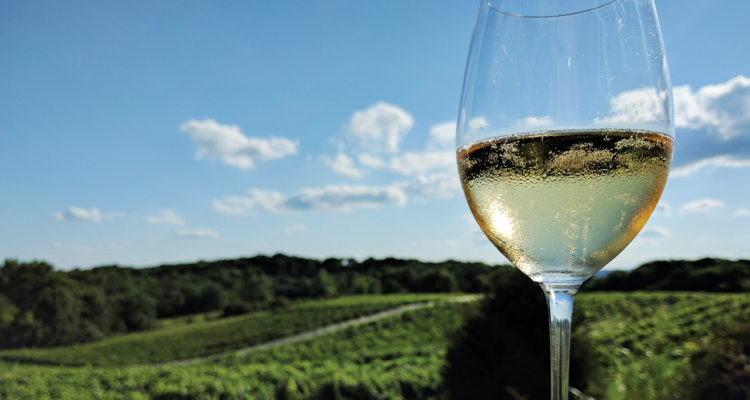Story by Dave Eckert
I drink my fair share of wine. Although I eschew the term “connoisseur,” having produced 275 episodes of my television show, Culinary Travels with Dave Eckert, which included multiple trips to most of the significant wine producing regions of the world and having amassed a wine cellar consisting of a couple thousand bottles, I like to think I know my way around a bottle of wine. Yet, wine continues to surprise and amaze me. This article is dedicated to some of the more recent pleasant surprises – bottlings from Missouri and Kansas wineries.
I’ve consumed Missouri wines off and on for nearly 30 years. And, though wines from Kansas are a newer discovery for me, I can honestly say wines on both sides of the state line have improved enormously in both selection and quality. I saw and tasted that first-hand at a Kansas City Homes and Style launch party where I sipped the offerings of Urich, Missouri’s Red Fox Winery & Vineyards.
“Red Fox is a family winery. We started growing grapes many years ago, and it slowly evolved into a winery. We sold grapes and juice to other wineries,” Kayvon Jaberian, the son of the founders, told me. “But, then I thought, ‘Hey, why couldn’t we make our own wine?’ And, here we are.”
There’s no lack of choice when it comes to Red Fox’s wines. Jaberian says he and his parents make 18 different wines. He brought three to the party – a Vignoles, a white grape that’s too sweet for my palate, a dry rose, which was pleasant, and a red blend called Three Oaks, which I really liked. Featuring Norton (the state’s best known red grape), Chambourcin, and Cabernet Franc, Three Oaks has good weight, a pleasant mouthfeel, and a long and persistent finish. If this is the future of Missouri red wine, I like the direction in which it’s heading.
RED FOX WINERY: PHOTOS BY TOM BARNHART
At the other end of the Kansas City Metro you will find Vox Vineyards. Specializing in rare, native grape varieties, Vox is raising the bar for Missouri wine. The grapes Vox uses were bred in the late 19th and early 20th century. Owner Jerry Eisterhold originally sourced more than 60 varieties and now grows about 30 on 13 acres. Eisterhold says better varietals along with increased and improved technology are leading the way to better wines.
“Viticultural skills and technologies are improving generally across the industry, and we are particularly focused on the specific qualities of our grapes, which are unique to the state and the wine industry in general,” Eisterhold stated.
But, of course the wineries are going to say their quality is on the rise. I sought an objective, informed, outside opinion. You certainly can’t get more informed than local wine expert Doug Frost who carries the titles Master of Wine and Master Sommelier.
“Absolutely things are getting better in both states. Winemakers are becoming experienced and skilled with the particular grapes that grow best in this area, and that experience results in better balanced wines. But, more importantly, smarter choices are being made in the vineyards with increased plantings of grapes such as Chambourcin, Muscat Valvin, Traminette, Vignoles, and others. Those grapes can make damned fine wine!” Frost opined.
PHOTOS COURTESY OF VOX VINEYARDS
Wine is Big Business
Just check out these numbers
- The Missouri wine industry has a $3.2-billion-dollar impact on the state’s economy
- It pays $2.18.5 million in federal taxes, and $144 million in state and local taxes, and $1.0 billion in annual wages
- There are more than 130 wineries in Missouri, 425 grape growers, and nearly 900,000 wine-related tourists annually
A much younger business on the Kansas side, the wine industry in the Sunflower State is nonetheless expanding rapidly. Dennis Reynolds with the Kansas Grape Growers & Winemakers Association and Somerset Ridge Winery in Paola shared this information.
- There are now 44 active wineries in Kansas
- There are 120 grape growers in the state
Although there hasn’t been an economic study of the Kansas wine industry in a decade, Reynolds says what he’s seen points to rapid growth and a larger economic impact.
Overall, Reynolds says the future looks bright for grapes and wines on the Kansas side. “We have more data across the board when it comes to the best grape varieties and the best grape growing and winemaking techniques, Reynolds shared.
Back at the party, I asked Jaberian if he thought even better wines were in his family’s future?
“Definitely. We have a lot to do. We’ve only just scratched the surface,” Jaberian concluded.
You’ll find similar optimism from Eisterhold and Vox Vineyards.
“If we have anything to say about it, there will be increased interest in, and appreciation of, the quality and diversity of wines that we can produce with our grapes,” Eisterhold summarized.
Diversity and quality – now those are two wine traits I can definitely wrap my palate around. Cheers!








